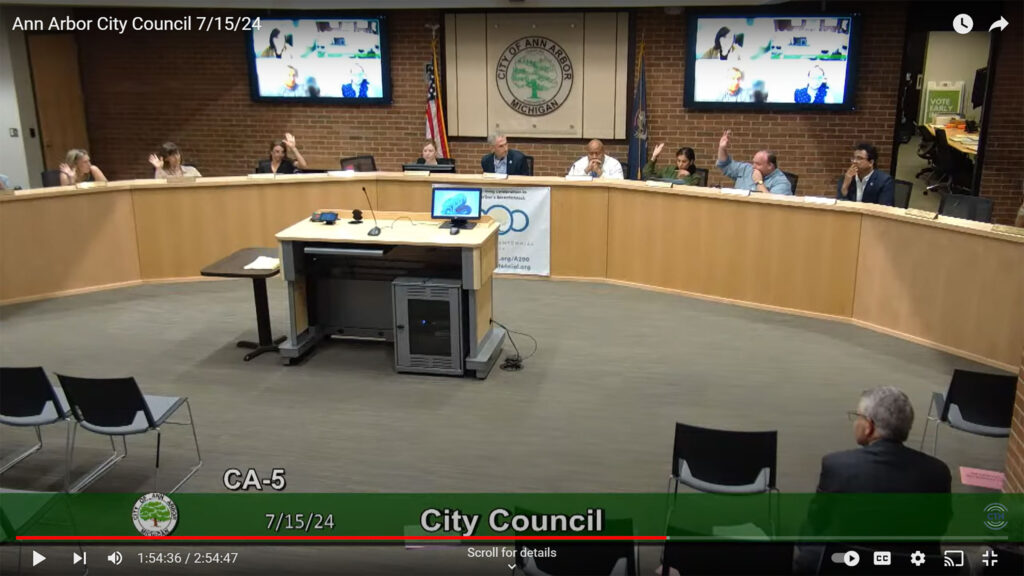The Ann Arbor City Council met Monday at Larcom City Hall to discuss plans to replace 4,000 high-pressure sodium streetlights. The resolution proposed replacing the bulbs with 58-watt LEDs. The change was proposed in line with the city of Ann Arbor’s goal to transition the city to 100% renewable energy by 2030.
The meeting began with 45 minutes of public comment. Ten of the 17 public speakers spoke against the proposal, citing the plan to use a single wattage bulb on both local and major roads. Major roads typically use brighter, higher wattage bulbs due to higher traffic volume and visibility. Meanwhile, local and suburban roads typically use lower wattage bulbs to prioritize resident comfort.
Ann Arbor community member Leslie Mason said the experience of having lightbulbs on her street replaced with higher wattage LEDs has disrupted her sleeping habits.
“I actually had this happen to me a few months ago,” Mason said. “(DTE) installed a very bright light in front of my house. I immediately noticed I couldn’t sleep at night because the light was illuminating my entire bedroom. My neighbors said it felt like a spotlight was shining in their window at night.”
James D’Amour, another local resident, urged council members to think not just about energy sustainability, but also about the sustainability of the local ecosystem.
“I like to look at this from a sustainability perspective,” Damour said. “We need to work together to ensure the reliability of natural systems. High beams affect nocturnal insects and organisms, particularly fireflies, but certainly many others. So we need to look at the whole picture when considering sustainability decisions.”
Following public input, Public Service Director Skye Stewart detailed the obstacles to replacing the current light bulbs with a combination of high and low wattage LEDs. She explained that bulbs under 58 watts are not typically carried by DTE and must be special ordered.
“DTE’s standard fixture color temperature is 4,000, a bright cool white, and the current standard wattage is 206 watts down from 58 watts,” Stewart said. “DTE’s original contract with the city called for all lighting to be converted to a standard 4,000 Kelvin color temperature as part of this project, with over 1,000 lights to be converted to a wattage of 58 watts or higher.”
Stewart explained that DTE has already done a lot of work to ensure the replacement LEDs won’t cause inconvenience to residents.
“Over the next several months, staff successfully finalized a revised agreement with DTE that will result in lighting that is warmer overall, with a color temperature of 2,700 Kelvin and nearly all fixtures being 58 watts.”
Stewart also said labor costs would be higher because of the need for additional staff to manage the various responsibilities required for multiple wattages.
“A lighting engineer (full-time equivalent or consultant support) will be required for the initial work of developing a lighting plan for each street to determine the recommended wattage for each DTE streetlight,” Stewart says. “In addition, a part-time inventory technician, etc. will be required for ongoing inventory management, tracking, verification, maintenance access, etc.”
When it comes to cost and power efficiency between a 58-watt bulb and a 28-watt bulb, the difference will be minimal compared to the efficiencies already achieved by switching to LEDs, Stewart said.
“Efficiency gains come from switching from less efficient, higher wattage high-pressure sodium lamps (up to 400 watts in some cases) to more efficient LED fixtures,” Stewart says. “The difference between installing a 58-watt LED light in one part of a fixture versus a 29-watt LED light will be relatively small in comparison.”
Due to the large negative reaction from residents and the many complex issues raised by Stewart, the City Council voted to postpone the vote on the resolution until the next City Council meeting.
Councilwoman Erica Briggs (D-District 5) said she is disappointed that DTE is trying to shift the costs to the city. She supported the amendment because it gives DTE the opportunity to find a more community-oriented solution.
“I would like to adjourn tonight’s meeting so that staff can go back to DTE and say this is a community priority and they shouldn’t charge us a fee,” Briggs said. “This is an asset that they should be planning for and we don’t need to significantly increase the full-time staff that we manage.”
Mayor Christopher Taylor also voiced support for a delay to give staff time to find a solution that is more acceptable to the entire community.
“I support this postponement because I look forward to staff working with DTE to determine if there are lower lumen alternatives that can be effectively and efficiently distributed across our local roadways.”
Taylor also expressed his gratitude to his staff and DTE for their hard work on the project.
“I really want to thank our staff for working on this,” Taylor said. “I also want to acknowledge DTE for working with us and communicating with us on this in a way that’s not their duty. They’re engaging with us on this. They can do more, and I hope they will.”
Daily staff reporter Lyla Wilder can be contacted at lyrawild@umich.edu.

